Everything You Need To Know About Effective Booth Design
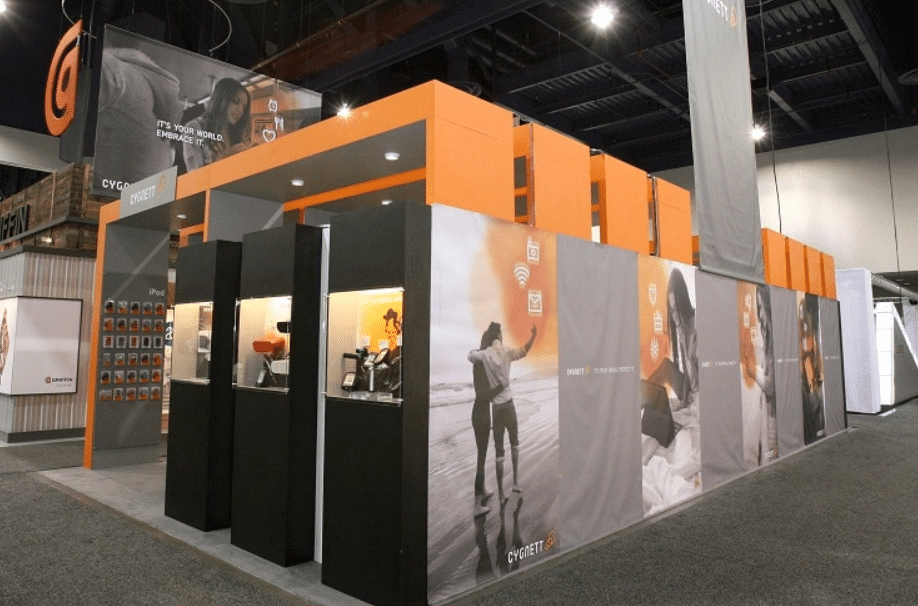
Achieving a standout exhibition booth design is not solely about drawing eyes; it's about creating an immersive experience that engages the curiosity of attendees. This involves your booth ideas with more than just aesthetics—it's an intricate blend of marketing strategy, brand expression, and compelling visuals that captures and holds the interest of your audience.
Crafting a successful trade show presence hinges on how well the Booth Design Essentials for Impactful Trade Show Presence
Achieving a standout exhibition booth design is not solely about drawing eyes; it's about creating an immersive experience that engages the curiosity of attendees. This process involves more than just aesthetics—it's an intricate blend of marketing strategy, brand expression, and compelling visuals that captures and holds the interest of your audience.
Crafting a successful trade show presence hinges on how well the booth uses your trade show booth ideas and communicates the brand message and connects with visitors. The power and value of expertly designed portable trade show booths is undeniable in a competitive event landscape, making every element count—from size and layout to the creative use of trends, ensuring your trade show booth design resonates with the event-goers and leaves a memorable impression.
Key Takeaways
- Engaging, bold graphics are critical for making lasting connections with trade show attendees.
- Strategic planning and design trends are essential for booth designs that effectively communicates your message to potential clients.
- The impact of large graphics and the perfect display goes beyond appearance, influencing visitor interaction to attract attendees.
Importance of Exceptional Booth Design
First Impressions Matter
The initial encounter between your booth and an attendee can significantly influence their perception of your brand. A well-designed booth establishes a memorable presence, encouraging further interaction, and potentially leading to increased sales. Opt for designs that capture attention and clearly communicate your marketing goals.
Facilitating Visitor Engagement
Portable displays must use banner stands and a back wall to be more than just visually appealing; they should be a nexus for interaction. Use striking graphics and inviting colors to draw visitors in, and create an atmosphere that fosters conversation and connection. Personalized experiences resonate deeply with visitors and can leave a long-lasting impression.
Distinguishing Your Brand
Amidst the buzz of a crowded trade show, your booth should shine with individuality. Stepping away from the commonplace gives your brand a distinctive edge, capturing the interest of attendees and decision-makers alike. Daring and well-thought-out fabric graphics can be the key at your next event to engaging with your target audience and outshining competitors.
Enhancing Functionality for Greater Impact
The practical design of your custom trade show back wall is critical for a successful exhibit. Customizing the space to meet your brand's specific requirements ensures a seamless and enriching experience for visitors. Smart spatial planning includes areas for both public demonstration and private discussions, ensuring that attendees can engage with your service or product comfortably.
Amplifying Brand Attractiveness
Your exhibit should embody the essence of your brand, from the core message to the visual details. For example, a reception counter that resonates with your brand's identity attracts visitors and inspires trust. When attendees see a booth that stands out with a strong brand message, it can effectively increase traffic and interest in what you have to offer.
By incorporating these elements into your budget and marketing goals, you present your brand as high-quality, engaging, and service-oriented, laying the foundation for a successful exhibition and potentially a high impact in boosting sales.
Essential Elements of Booth Design
- Budget Awareness: It's vital to balance creativity with financial constraints.
- Sales Growth: Well-crafted designs have shown to enhance sales figures.
- Networking Expansion: Strategically designed booths can widen professional connections.
- Maximizing Returns: A thought-out booth design correlates with higher returns on investment.
Essential Considerations for Exhibition Booth Design
Crucial Factors for Booth Design Planning
When planning an exhibition booth design, key elements like brand representation, attendee flow, eye-catching graphics and images, accessible product displays, and interactive components should be top of mind.
- Brand Consistency: All aspects should align with company branding.
- Attendee Traffic: Design for natural flow and avoid congestion.
- Visual Appeal: Use high-impact graphics to draw attention.
- Product Interaction: Facilitate hands-on engagement with products.
- Engagement Tools: Incorporate multimedia and live demonstrations.
Designing Impactful Booths Within Budget Constraints
Creating an engaging booth setup while maintaining budget discipline can be challenging but achievable.
- Focus on Core Elements: Invest in quality graphics and a distinctive feature.
- DIY Elements: Consider self-designed components where feasible.
- Rental Options: Rent structures instead of purchasing.
- Strategic Lighting: Use lighting effectively to create a high-end feel.
Innovating in Limited Space for Trade Show Booths
Maximizing a 10x10 trade show display booth requires creativity to make the most of the space.
- Vertical Integration: Use the height of the booth for branding and display.
- Furniture Selection: Choose slim, multifunctional furnishings.
- Mirrors: Use mirrors to create an illusion of more space.
- Clear Pathways: Keep the design open to facilitate movement.
Leveraging Booth Design in Educational Settings
Schools can employ booth design tactics to enhance learning and engagement during educational fairs.
- Interactive Displays: Use quizzes, puzzles, and games related to the educational content.
- Thematic Decor: Decorate the booth in line with the subject of interest.
- Digital Integration: Integrate tablets or screens with educational software.
Tactics for Increasing Trade Show Booth Engagement
Strategies to boost visitor interaction at trade show booths are key to success.
- Live Demos: Showcase products in action to gather crowds.
- Interactive Technology: Incorporate VR or AR for immersive experiences.
- Contests and Giveaways: Hold contests with prizes to attract participants.
- Staff Training: Ensure booth staff are friendly, knowledgeable, and engaging.
Budgeting for a Large-Scale Trade Show Booth
Investment expectations for a 20x20 industry exhibition booth can vary widely.
- Basic Expenses: Consider costs such as space rental, booth design, and travel.
- Custom Elements: Account for custom design work and special features.
- Staffing and Promotions: Include the cost of staffing and any promotional materials.
- Ancillary Costs: Remember to budget for any ancillary services needed. communicates the brand message and connects with visitors. The power of an expertly designed booth is undeniable in a competitive event landscape, making every element count—from size and layout to the creative use of trends, ensuring your booth resonates with the event-goers and leaves a memorable impression.
Key Takeaways
- Engaging booth design is critical for making lasting connections with trade show attendees.
- Strategic planning and design trends are essential for a booth that effectively communicates the brand.
- The impact of booth design goes beyond appearance, influencing visitor interaction and brand perception.
Importance of Exceptional Booth Design
First Impressions Matter
The initial encounter between your booth and an attendee can significantly influence their perception of your brand. A well-designed booth establishes a memorable presence, encouraging further interaction, and potentially leading to increased sales. Opt for designs that capture attention and clearly communicate what your brand stands for.
Facilitating Visitor Engagement
An exhibition space must be more than just visually appealing; it should be a nexus for interaction and ideas. Use striking graphics and inviting colors to draw visitors in, and create an atmosphere that fosters conversation and connection. Personalized experiences resonate deeply with attendees and can leave a long-lasting impression.
Distinguishing Your Brand
Amidst the buzz of a crowded trade show floor, your booth should shine with individuality. Stepping away from the commonplace gives your brand a distinctive edge, capturing the interest of attendees and decision-makers alike. A daring and well-thought-out booth design can be the key to engaging with your target audience and outshining competitors.
Enhancing Functionality for Greater Impact
The practical design of your booth is critical for a successful exhibit. Customizing the space to meet your brand's specific requirements ensures a seamless and enriching experience for your team and visitors. Smart spatial planning includes areas for both public demonstration and private discussions, ensuring that attendees can engage with your service or product comfortably.
Amplifying Brand Attractiveness
Your exhibit should embody the essence of your brand, from the core message to the visual details. A booth that resonates with your brand's identity attracts more visitors and inspires trust. When attendees see a booth that stands out with a strong brand message, it can effectively increase traffic and interest in what you have to offer.
By incorporating these elements into your booth floor design, you present your brand as high-quality, engaging, and service-oriented, laying the foundation for a successful exhibition and potentially boosting sales.
Booth Design Dimensions
Configurations of Trade Show Structures
Trade show structures are commonly configured in three primary forms: in-line, triangular station, and freestanding quadrilateral.
- In-Line Booths These rectangular spaces commonly span 10 feet by 10 feet and position exhibitors in a continuous row with neighboring stalls. Attendees can engage directly from a singular open side.
Larger configurations such as 10 feet by 20 feet or 10 feet by 30 feet may be utilized for elevated presence. These cost-efficient solutions may be particularly appealing for newcomers to trade exhibits or those operating within a stringent budget.
Inline booths are an ideal booth design if you are exhibiting for the first time and/or if you are working on a slim budget.
They are smaller and are quite affordable. Plus, they are good for a small and simple trade show.
But the disadvantage is that linear booths are not as visible as the peninsula and island booths. Also, they can only receive traffic from one side. - Freestanding Island Booths Freestanding island or quadrilateral exhibits, encompassing a minimum area of 20 feet by 20 feet, are solitary units with access from all surrounding walkways, much like a standalone landmass. They facilitate increased attendee traffic and the opportunity for hanging components from overhead, potentially expanding usable exhibiting space.
The primary trade-off is a steeper cost, which may render these less feasible for those with tighter financial constraints. - Triangular Station Booths (Peninsula Booths) Triangular station setups command visibility with three accessible sides and one fixed backdrop. These spaces often occupy a 20 feet by 20 feet footprint, albeit variations do exist. They offer a compromise between the in-line and freestanding quadrilateral formats, being more accessible than the former while not as costly as the latter. The drawback here is the limited ability to increase vertical elements compared to freestanding quadrilateral structures.
Key Considerations
Businesses should weigh the advantages and challenges each exhibit style presents. While grander constructs may be enticing, they should be evaluated against available resources and possible return on investment. Assessing the right fit, size and form of the booth that aligns most effectively with your business objectives and budget is crucial for success in the competitive environment of trade shows.
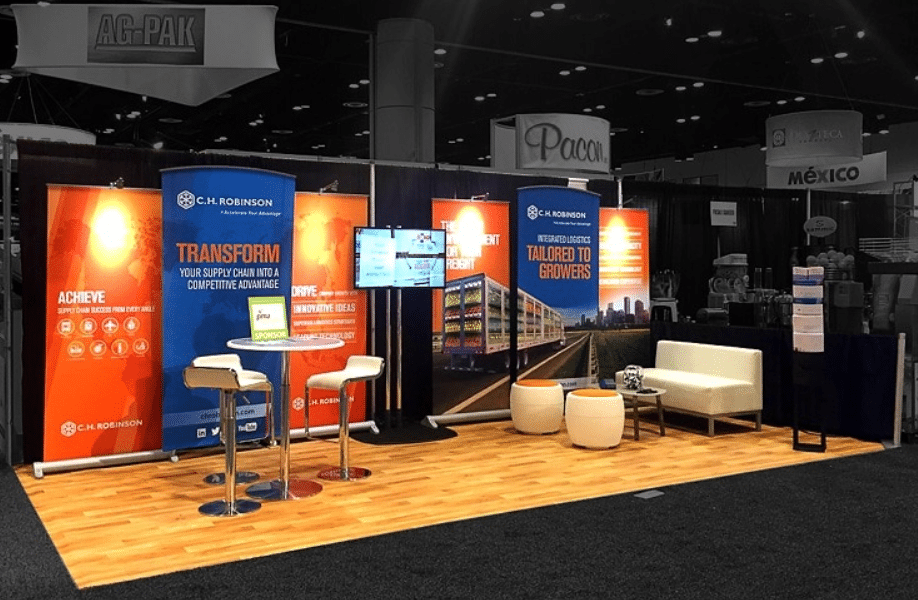
Renting Exhibit Spaces for Trade Events
Exhibit spaces at trade fairs provide businesses with a non-permanent solution that allows them to present a fresh and current face to industry colleagues and potential customers. The last thing any company wants is to detract from their innovative image with outdated displays at such pivotal events.
When opting for a rental stand, companies benefit from the ability to tailor the design to align closely with their brand identity. Providers of these spaces, especially well-established ones, typically offer a broad range of personalization options.
Furthermore, when renting, the headaches of storage, transport, and continued upkeep fall to the provider, not the business using the booth. This convenience is a significant advantage for businesses looking to minimize logistical concerns.
However, there are drawbacks to consider. The costs associated with renting could become unsustainable for many exhibitors and businesses attending multiple events throughout the year. Regular exhibitors at numerous conferences, such as the International Consumer Electronics Show (CES) or the Specialty Management Market Association (SEMA), may find that these expenses accumulate swiftly.
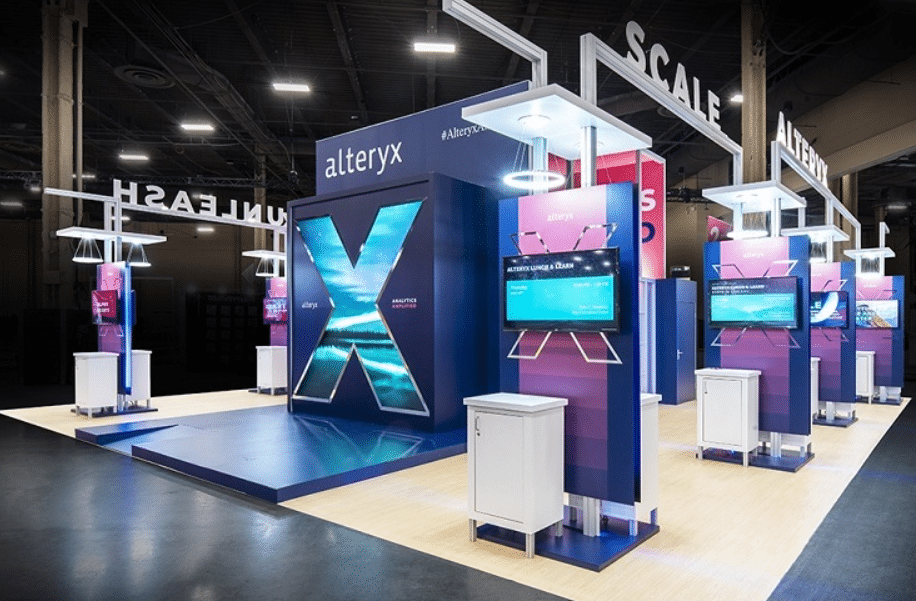
Comparison of Exhibit Space Costs at CES and SEMA
When comparing the costs of renting exhibition spaces at CES and SEMA, businesses should carefully plan their budgets. Display booth and stand rentals at the Consumer Electronics Show (CES) range as follows:
10' x 10' Booth: $12,000 - $19,000
10' x 20' Booth: $16,000 - $23,000
20' x 20' Booth: $30,000 - $50,000
30' x 30' Booth: $40,000 - $60,000
In contrast, the Specialty Equipment Market Association (SEMA) Show typically offers more economical options:
20' x 20' Booth: Starting from $8,000
Cost per Square Foot: $36.95 for non-member attendees
Given the significant investment required for booth rental, exhibitors are advised to focus on strategies that ensure a substantial return on investment (ROI).
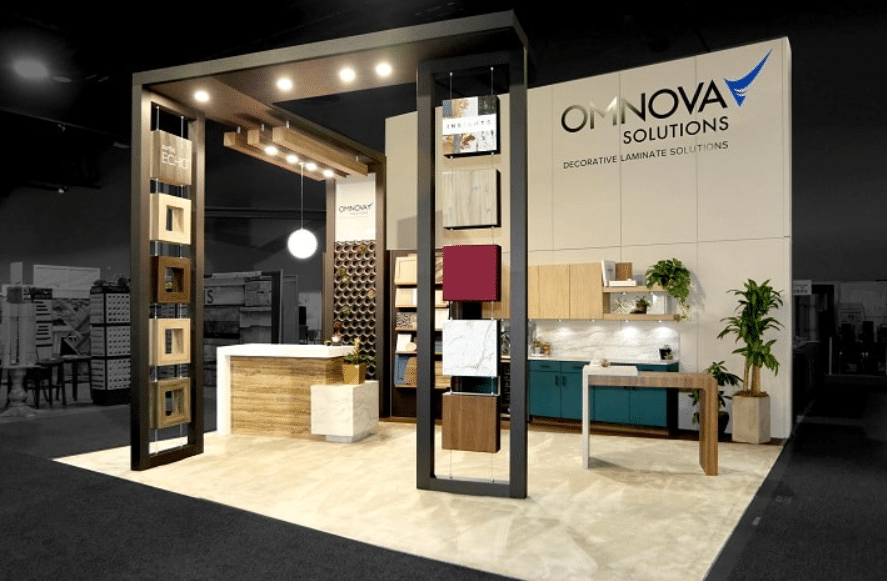
Key Components of Effective Exhibit Architecture
Visual Color Harmony
In the realm of exhibit design, the strategic use of a color scheme plays a pivotal role in drawing visitors and conveying the desired message. Employing a harmonious blend of hues not only enhances the aesthetic appeal of a booth but also leverages color psychology to engage with the audience on a subconscious level. Visitors might be subtly influenced by specific color pairings – for instance, cool colors such as green, blue, and white exude professionalism, while the warm vibrancy of yellow, orange, and red demands attention. However, care must be taken to balance these more aggressive tones to avoid overwhelming the attendees.
Illumination Strategies
Lighting is a cornerstone of trade show booth design, with the power to establish ambiance and uplift the mood of any space. Customization is key, with various lighting techniques available to achieve specific goals. It is imperative to ensure that lighting is evenly distributed throughout the booth, reaching even commonly neglected areas. Embracing a spectrum of lighting options, from the subtle to the bold, can create a welcoming environment. Including colored illumination may serve as a tasteful complement to the overall design, casting a flattering glow on both the staff and the space.
Thoughtful Adornments
When it comes to decorations, coherence and clarity are paramount. Every element, from banners to display items, speaks volumes about the brand, underscoring the importance of unified graphics, color stories, and aligned messaging. Banner sizing is crucial; larger displays tend to capture more interest but need to resonate with the quality and proportion of the booth to avoid appearing disconnected. Simplistic yet compelling decorative choices prevent clutter and foster an enticing, professional front.
Color harmonization should reflect brand colors and apply color psychology effectively.
Interactive elements and graphic design help in drawing interest and keeping the audience engaged.
Importance of customized lighting for mood setting and highlighting key areas or products.
Layout and design elements need to be consistent with marketing goals and product style.
The inclusion of furniture, such as counters and kiosks, should be strategic, enhancing both aesthetics and functionality.
Utilizing technology thoughtfully, for example, charging ports, to improve attendee experience.
Product displays and demonstration areas should be easily accessible and well-integrated into the overall design.
Professional designers can assist in effectively incorporating these elements into an exhibit.
Storage solutions need to be incorporated seamlessly to maintain a clean and organized appearance.
A backlit display, logos, and consistent branding materials play a crucial role in recognition and appeal.
Provision of seating or lounge areas, potentially incorporating charging ports for added convenience.
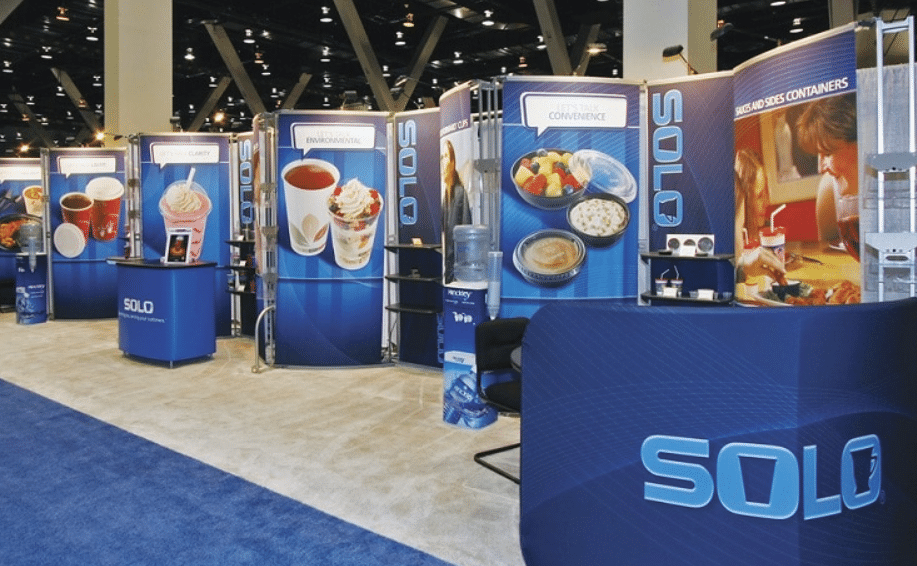
Essential Elements of Booth Design
Budget Awareness: It's vital to balance creativity with financial constraints.
Sales Growth: Well-crafted designs have shown to enhance sales figures.
Networking Expansion: Strategically designed booths can widen professional connections.
Maximizing Returns: A thought-out booth design correlates with higher returns on investment.
Leverage resources from websites like Exponents and ModDisplays for innovative yet budget-conscious designs.
Essential Considerations for Exhibition Booth Design
Crucial Factors for Booth Design Planning
When planning an exhibition booth design, key elements like brand representation, attendee flow, eye-catching graphics and images, accessible product displays, and interactive components should be top of mind.
Brand Consistency: All aspects should align with company branding.
Attendee Traffic: Design for natural flow and avoid congestion.
Visual Appeal: Use high-impact graphics to draw attention.
Product Interaction: Facilitate hands-on engagement with products.
Engagement Tools: Incorporate multimedia and live demonstrations.
Designing Impactful Booths Within Budget Constraints
Creating an engaging booth setup while maintaining budget discipline can be challenging but achievable.
Focus on Core Elements: Invest in quality graphics and a distinctive feature.
DIY Elements: Consider self-designed components where feasible.
Rental Options: Rent structures instead of purchasing.
Strategic Lighting: Use lighting effectively to create a high-end feel.
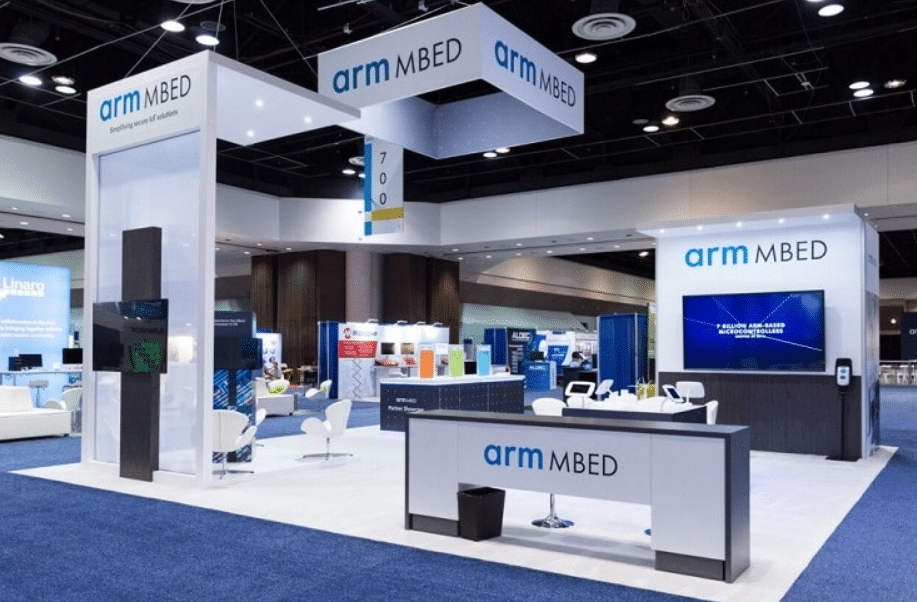
Innovating in Limited Space for Trade Show Booths
Maximizing a 10x10 trade show display booth requires creativity to make the most of the space.
Vertical Integration: Use the height of the booth for branding and display.
Furniture Selection: Choose slim, multifunctional furnishings.
Mirrors: Use mirrors to create an illusion of more space.
Clear Pathways: Keep the design open to facilitate movement.
Leveraging Booth Design in Educational Settings
Schools can employ booth design tactics to enhance learning and engagement during educational fairs.
Interactive Displays: Use quizzes, puzzles, and games related to the educational content.
Thematic Decor: Decorate the booth in line with the subject of interest.
Digital Integration: Integrate tablets or screens with educational software.
Tactics for Increasing Trade Show Booth Engagement
Strategies to boost visitor interaction at trade show booths are key to success.
Live Demos: Showcase products in action to gather crowds.
Interactive Technology: Incorporate VR or AR for immersive experiences.
Contests and Giveaways: Hold contests with prizes to attract participants.
Staff Training: Ensure booth staff are friendly, knowledgeable, and engaging.
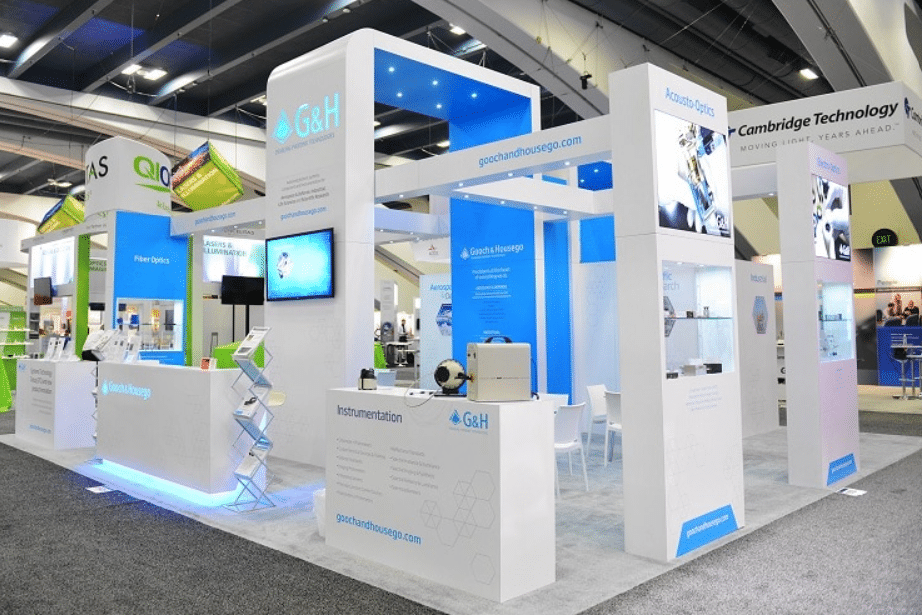
Budgeting for a Large-Scale Trade Show Booth
Investment expectations for a 20x20 industry exhibition booth can vary widely.
- Basic Expenses: Consider costs such as space rental, booth design, and travel.
- Custom Elements: Account for custom design work and special features.
- Staffing and Promotions: Include the cost of staffing and any promotional materials.
- Ancillary Costs: Remember to budget for any ancillary services needed.
Conclusion
In conclusion, booth design is a key element that can determine the success of your trade show or exhibition. A thoughtful and well-designed booth not only attracts and engages visitors but also communicates your brand message effectively. While there are different types of booth designs to choose from, your decision should meet your business needs and budget. Whether you opt to rent or own, each option comes with its unique benefits and potential drawbacks. But remember, a well-structured booth rich in color, lighting, and decorations can significantly boost your networking opportunities, sales, and ultimately, your return on investment. So, invest wisely and creatively in your booth design, and watch your brand shine.
An excellent booth design is an essential part of a successful exhibition. It has the potential to increase your network, boost sales, and maximize your ROI.
Resources:
